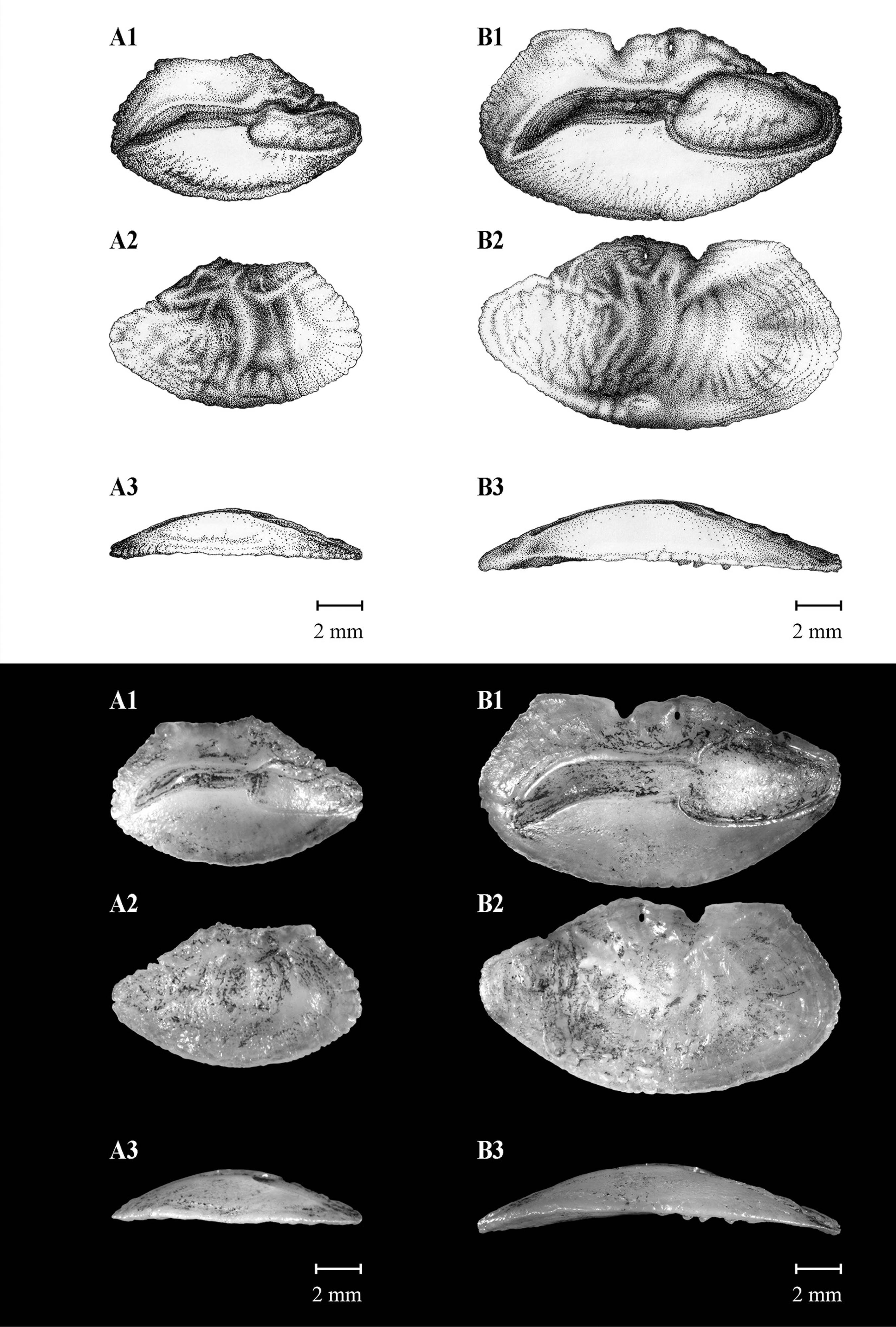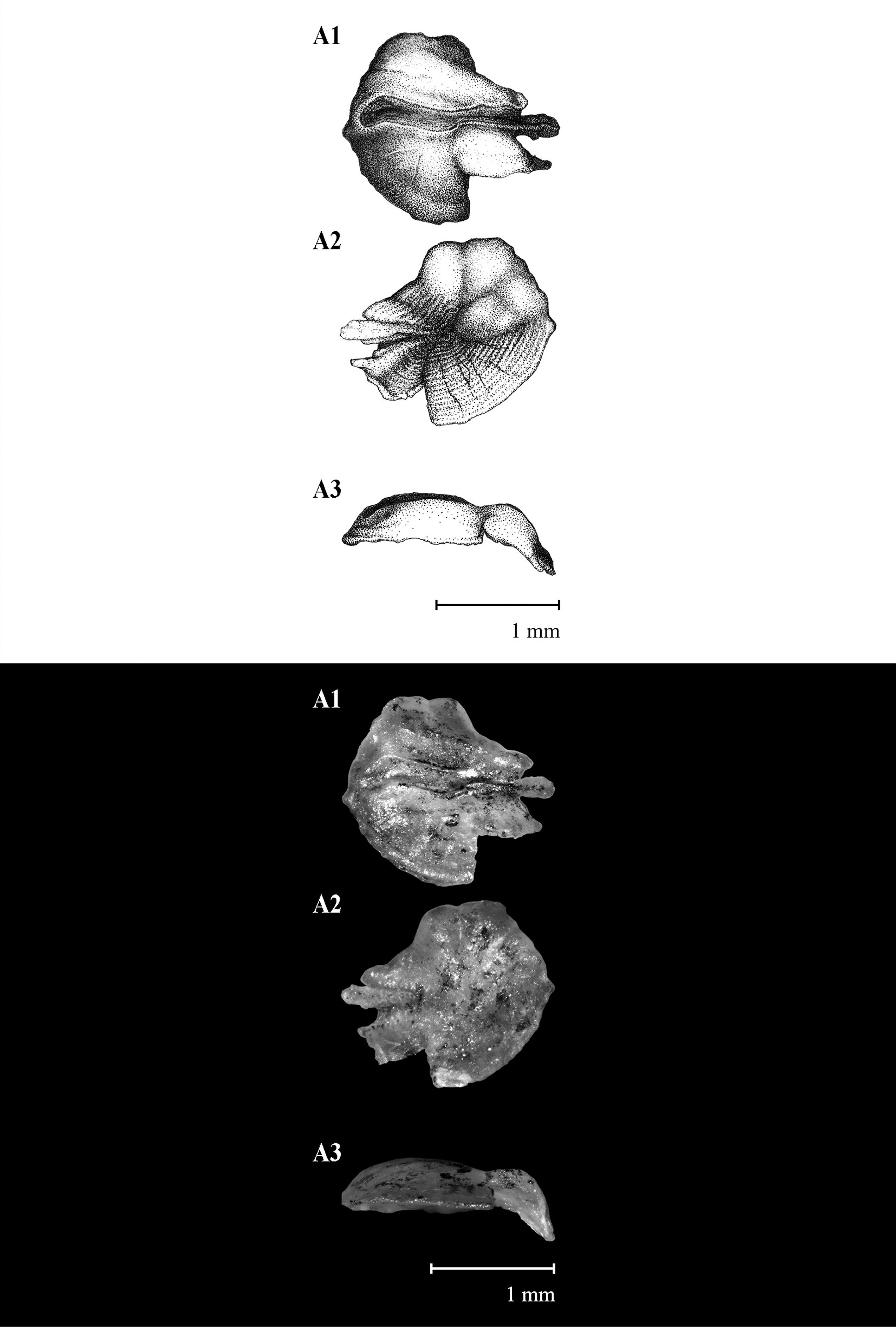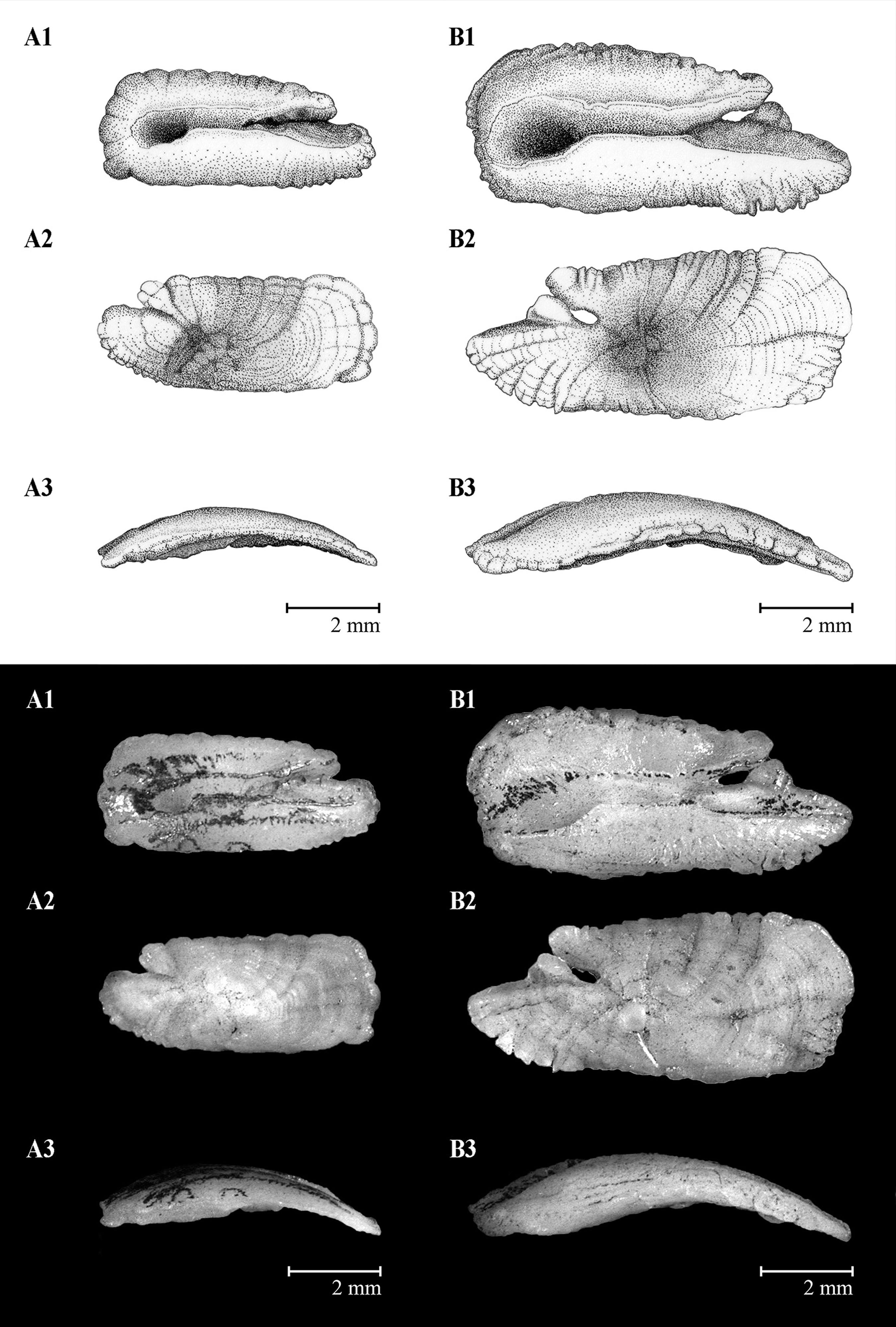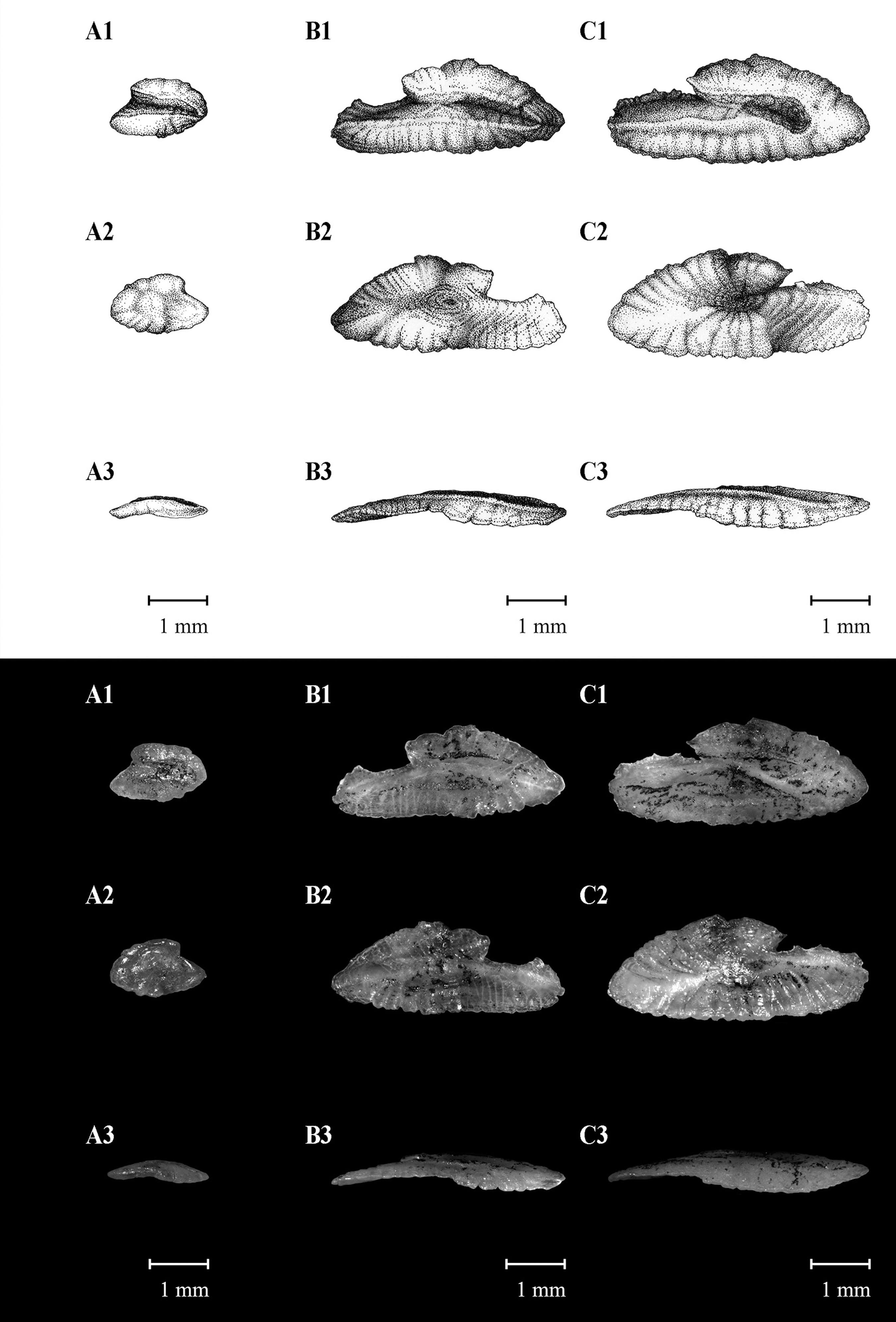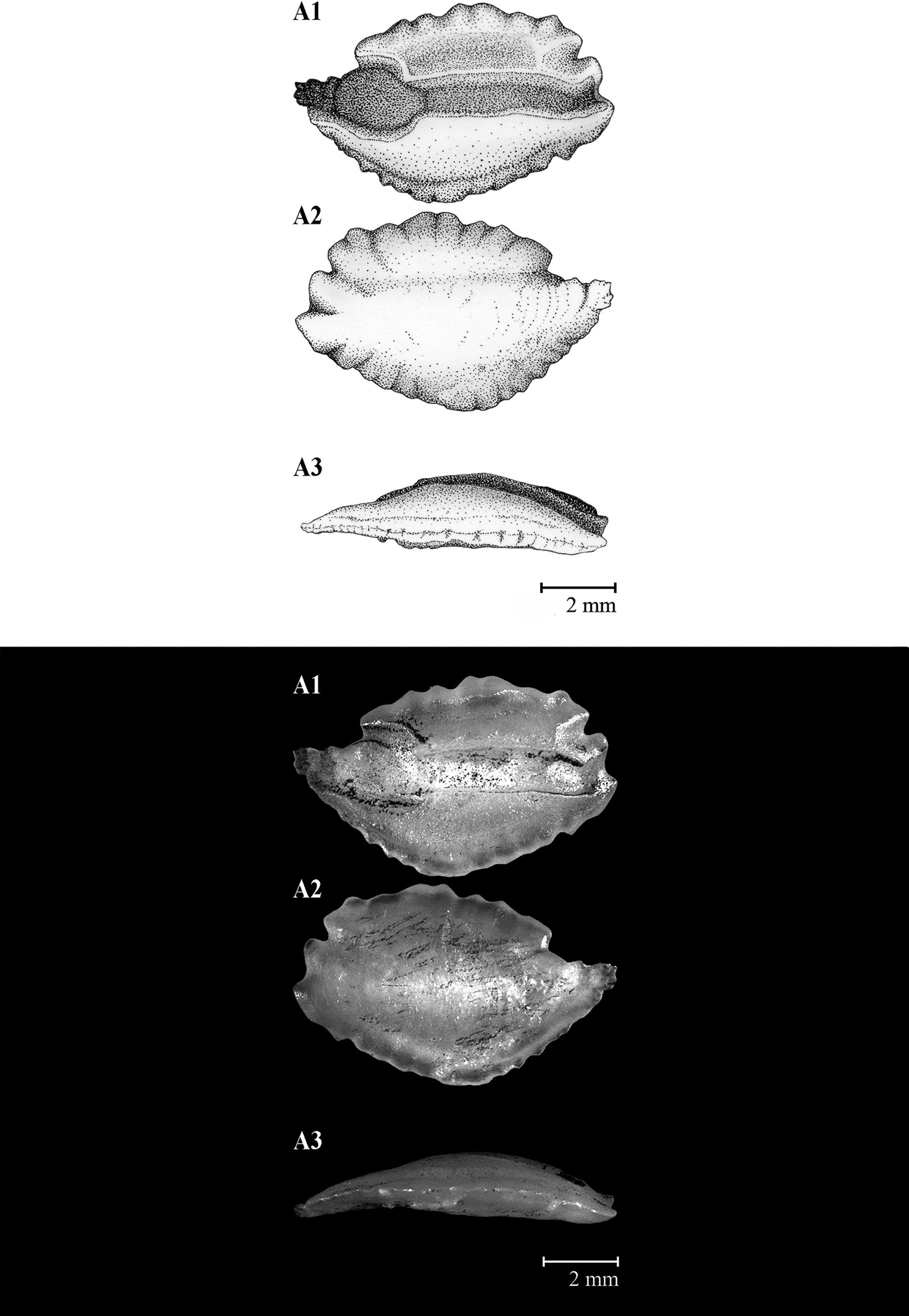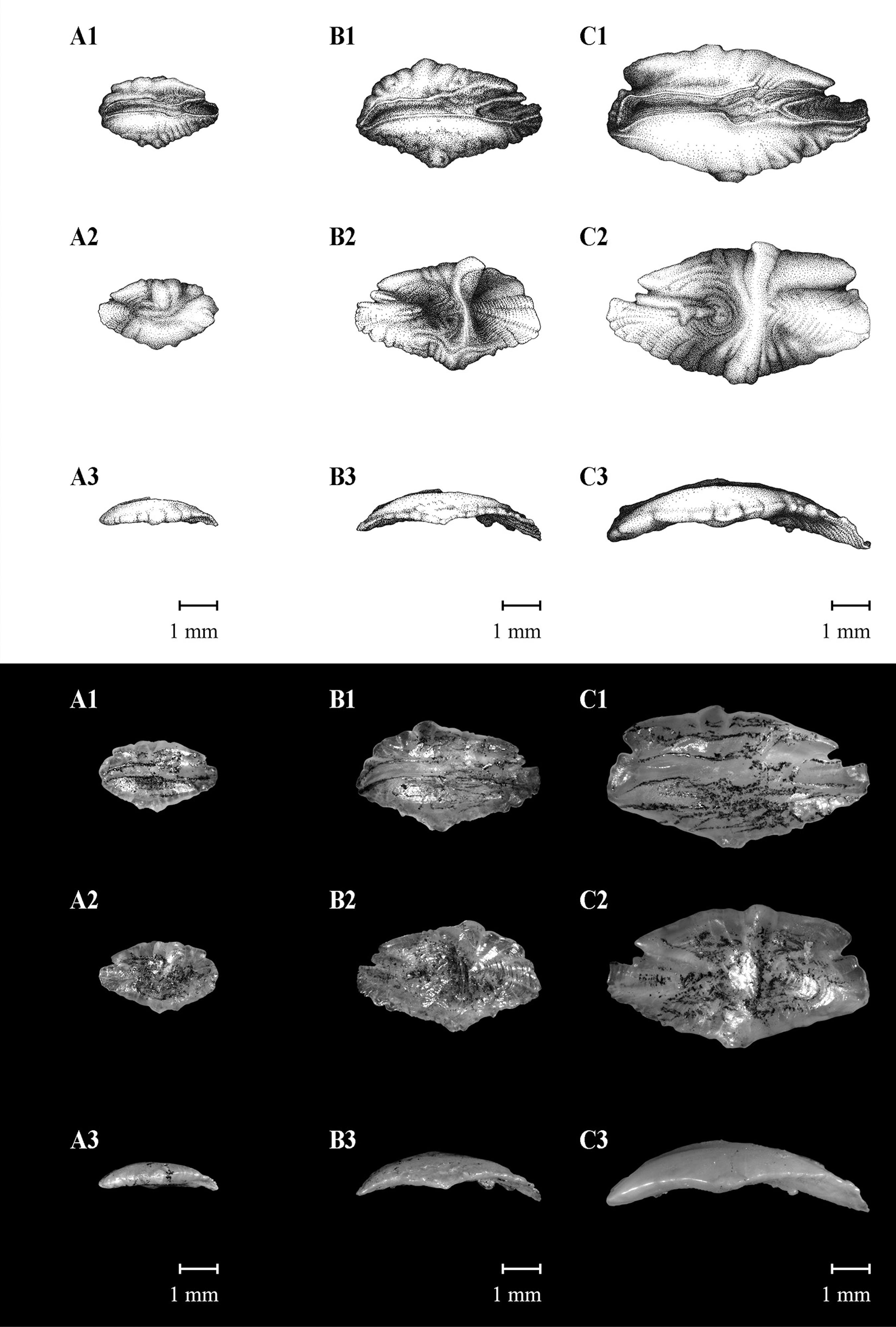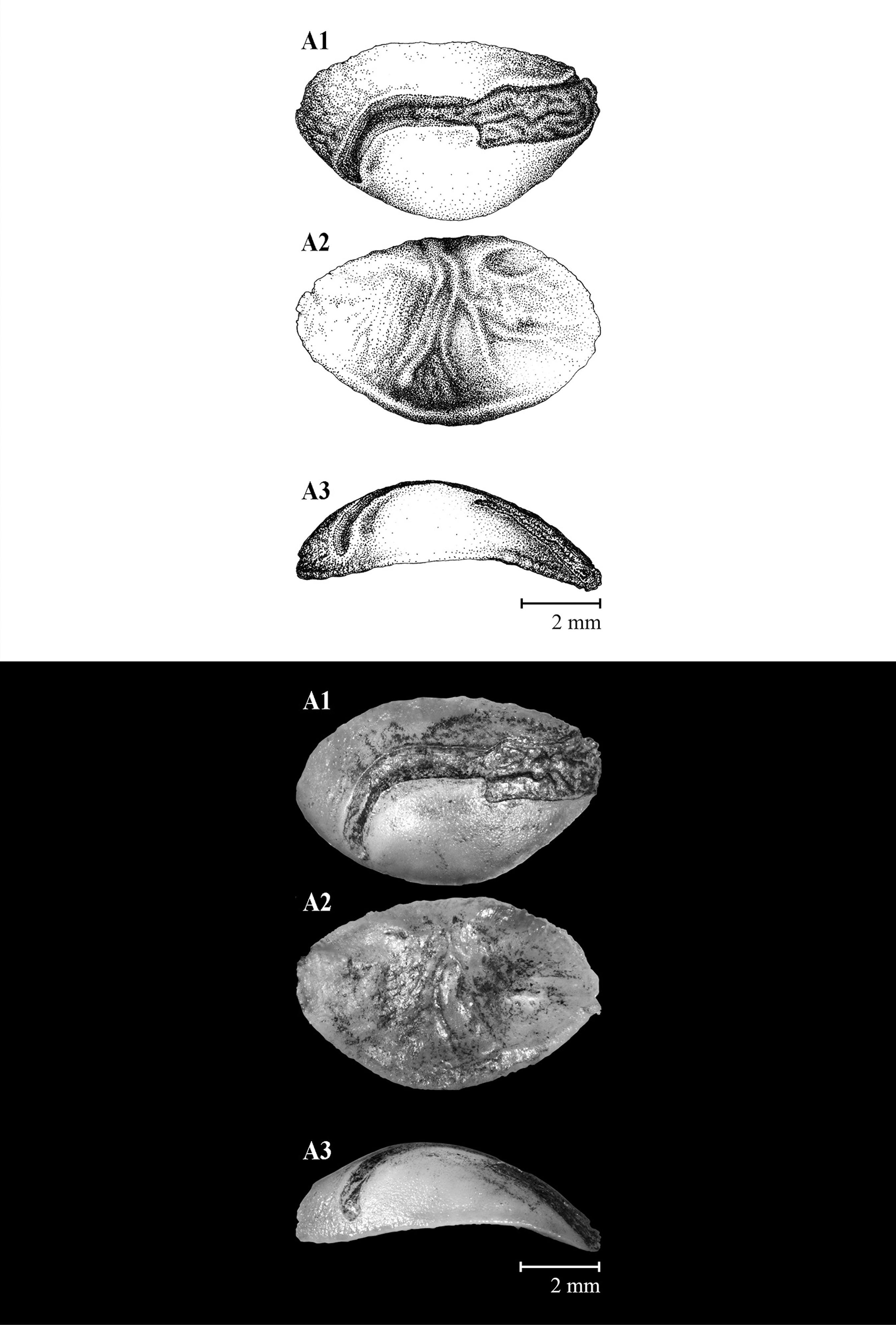ABSTRACT
This publication is part of a series that will constitute an Atlas of Teleostei Otoliths for the Southeastern-Southern Brazilian area. It presents the results of the morphological and morphometric analyses of 31 Perciformes (two species of Centropomidae; two of Acropomatidae; two of Serranidae; two of Priacanthidae; two of Malacanthidae; one of Pomatomidae; six of Carangidae; three of Lutjanidae; five of Gerreidae and six of Haemulidae). Whenever available in the collection, otoliths from three distinct specimen sizes were illustrated and photographed in order to show their variation during development. For each characteristic the frequency of occurrence was calculated within each length class (TL) and among length classes (during development) and differences were analyzed by a multiple χ² test (significance 0.05).
Descriptors:
Otoliths; Morphology; Morphometry; Southwestern Atlantic; Brazil; Perciformes
RESUMO
Esta publicação é parte de uma série que constituirá um Atlas de Otólitos para os Teleostei da Região Sudeste-Sul brasileira. Nela são apresentados os resultados de análises morfológicas e morfométricas de 31 espécies de peixes Perciformes (duas espécies de Centropomidae; duas de Acropomatidae; duas de Serranidae; duas de Priacanthidae; duas de Malacanthidae; uma de Pomatomidae; seis de Carangidae; três de Lutjanidae; cinco de Gerreidae e seis de Haemulidae). Três otólitos de tamanhos distintos de cada espécie foram desenhados e fotografados, sempre que possível. Para cada característica foram calculadas as frequências de ocorrência dentro de cada classe de comprimento total (TL) e entre classes distintas (diferenças ontogenéticas) através de um Teste χ² múltiplo (significância 0,05).
Descritores:
Otólitos; Morfologia; Morfometria; Atlântico Sudoeste; Brasil; Perciformes
INTRODUCTION
Many papers have been published showing the value of otolith photographs and drawings for the analysis of the features of these structures in such different areas as: taxonomy, phylogeny, archeology, paleontology, species geographic variation, stock identification, food webs and others.
Since the 1990s the potential of the otolith collections has become clear as revealing supporting analyses of population structure, growth dynamics, and environmental conditions (Geffen; Morales-Nin, 2013GEFFEN, A. J.; MORALES-NIN, B. Fish otoliths: national treasures that can enrich ICES science. ICES Insight, v. 50. p. 44-49, 2013.) and recently, otolith collections have come to be useful in focusing on otolith analysis as indicative of past environmental events.
This publication is part of a series that will constitute an Atlas providing a permanent visual record of otoliths of fish species from the Southeastern-Southern Brazilian coast, providing a valuable legacy for otolith shape and size analysis.
MATERIAL AND METHODS
The sampling area and the methodology followed Rossi-Wongtschowski et al. (2014)ROSSI-WONGTSCHOWSKI, C. L. D. B.; SILIPRANDI, C. C.; BRENHA, M. R.; GONSALES, S. A.; SANTIFICETUR, C.; VAZ-DOS-SANTOS, A. M. Atlas of marine bony fish otoliths (sagittae) of Southeastern-southern Brazil. Part I: Gadiformes (Macrouridae, Moridae, Bregmacerotidae, Phycidae and Merlucciidae); Part II: Perciformes (Carangidae, Sciaenidae, Scombridae and Serranidae). Braz. J. Oceanogr., v. 62, n. (special issue1), p. 1-103, 2014.. Additionally this paper includes otoliths from two new surveys as follows:
-
Araçá Bay Project (BA) I, II, III, IV and V. "Biodiversity and functioning of a subtropical coastal ecosystem: support for integrated management", undertaken between 2010 and 2014.
-
Araçá Bay Project (BA) I, II, III and IV. "Ichthyofauna composition and abundance of tidal pools at Araçá Bay, São Sebastião (SP) and their space-temporal patterns", conducted in 2014.
The acronyms in the shape indices tables represent: TL= total fish length, OL= otolith length, OH= otolith height and OT= otolith thickness.
RESULTS
PART IV: PERCIFORMES
Family CENTROPOMIDAE
Otolith shape varies from elliptic to trapezoidal, the anterior region tends to be peaked-round, cauda morphology is always tubular strongly curved, pseudorostrum and pseudoantirostrum are always absent.
Illustrations (above) and photographs (below) of Centropomus parallelus otoliths from fish with total lengths: A. 246 mm; B. 405 mm. The medial face is shown in A1, B1; the lateral face in A2, B2; and the ventral profile in A3, B3 (Illustration and Photos: Alexandre Arackawa).
Shape: elliptic to trapezoidal. Anterior region: peaked-round (85.71%), angled-round. Posterior region: oblique (42.86%), round, angled-round. Dorsal edge: sinuate to entire (57.14%), crenate to entire, lobed to entire. Ventral edge: sinuate to entire (28.57%), entire (28.57%), crenate (21.43%), crenate to entire, lobed to entire. Profile: concave-convex. Rostrum and antirostrum orientation: does not apply. Rostrum: developed. Antirostrum: absent. Sulcus acusticus: position: median; orientation: horizontal; opening: pseudo-ostial (50%), para-ostial (50%); morphology: heterosulcoid; colliculum: heteromorphic; ostium: elliptic (71.43%), rectangular; cauda: tubular strongly curved.
Significant differences (p<0.05) were obtained within some length classes for rostrum and antirostrum orientation. During growth development statistical differences were only found for the anterior region.
Illustrations (above) and photographs (below) of Centropomus undecimalis otoliths from fish with total lengths: A. 146 mm; B. 250 mm; C. 382 mm. The medial face is shown in A1, B1, C1; the lateral face in A2, B2, C2; and the ventral profile in A3, B3, C3 (Illustration and Photos: Alexandre Arackawa).
Shape: elliptic to trapezoidal. Anterior region: peaked-round. Posterior region: oblique (43.75%), round (37.50%), angled-round. Dorsal edge: sinuate to entire (37.50%), lobed to sinuate (31.25%), crenate to lobed, sinuate. Ventral edge: sinuate to entire (56.25%), lobed to sinuate, entire. Profile: concave-convex. Rostrum and antirostrum orientation: in agreement (68.75%), does not apply. Rostrum: developed. Antirostrum: underdeveloped (37.50%), absent (31.25%), developed (31.25%). Sulcus acusticus: position: median; orientation: horizontal; opening: ostial; morphology: heterosulcoid; colliculum: heteromorphic; ostium: elliptic (93.75%), rectangular; cauda: tubular strongly curved.
Significant differences (p<0.05) were obtained within some length classes for anterior region and ostium. No differences appeared during growth development.
Family ACROPOMATIDAE
The otoliths from two species of the collection are very different, but the sulcus acusticus opening is ostial, the ostium morphology is frequently funnel-like, pseudorostrum and pseudoantirostrum are always absent.
Illustrations (above) and photographs (below) of Synagrops bellus otoliths from fish with total lengths: A. 79 mm; B. 177 mm; C. 290 mm. The medial face is shown in A1, B1, C1; the lateral face in A2, B2, C2; and the ventral profile in A3, B3, C3 (Illustration and Photos: Alexandre Arackawa).
Shape: elliptic to trapezoidal (53.03%), trapezoidal, elliptic. Anterior region: peaked. Posterior region: oblique (42.86%), oblique-round, round, flattened. Dorsal edge: lobed to sinuate (58.16%), sinuate to entire. Ventral edge: sinuate to entire (57.14%), lobed to entire, serrate to entire, dentate to entire. Profile: concave-convex. Rostrum and antirostrum orientation: in agreement. Rostrum: underdeveloped. Antirostrum: underdeveloped. Sulcus acusticus: position: median; orientation: ascending (94.90%), horizontal; opening: ostial; morphology: heterosulcoid; colliculum: heteromorphic; ostium: funnel-like; cauda: tubular curled (62.24%), tubular markedly curved.
Significant differences (p<0.05) were obtained within some length classes for shape, posterior region, dorsal edge, ventral edge and sulcus acusticus orientation. During growth development statistical differences were found for shape, posterior region, dorsal edge, ventral edge and sulcus acusticus orientation.
Illustrations (above) and photographs (below) of Synagrops spinosus otoliths from fish with total lengths: A. 51 mm; B. 85 mm; C. 158 mm. The medial face is shown in A1, B1, C1; the lateral face in A2, B2, C2; and the ventral profile in A3, B3, C3 (Illustration and Photos: Alexandre Arackawa).
Shape: elliptic (61.43%), rhomboidal. Anterior region: peaked. Posterior region: round (68.57%), angled, oblique, flattened. Dorsal edge: sinuate to entire (67.14%), lobed to sinuate entire. Ventral edge: sinuate to entire (64.29%), lobed to sinuate, entire. Profile: flattened. Rostrum and antirostrum orientation: does not apply (71.43%), in agreement. Rostrum: developed. Antirostrum: absent (71.43%), underdeveloped, developed. Sulcus acusticus: position: median; orientation: horizontal; opening: ostial; morphology: heterosulcoid; colliculum: heteromorphic; ostium: funnel-like (85.71%), elliptic; cauda: tubular straight (57.14%), tubular slightly curved, tubular strongly curved.
Significant differences (p<0.05) were obtained within some length classes for shape, posterior region, dorsal edge, ventral edge, sulcus acusticus orientation, ostium and cauda morphology, rostrum and antirostrum orientation and antirostrum development. During fish development statistical differences were found for shape, rostrum and antirostrum orientation and antirostrum.
Family SERRANIDAE
Anterior region peaked-round, sulcus acusticus opening is ostial, ostium is longer and approximately equal to the cauda length, pseudorostrum and pseudoantirostrum are always absent.
Illustrations (above) and photographs (below) of Epinephelus marginatus otoliths from fish with total lengths: A. 210 mm; B. 308 mm. The medial face is shown in A1, B1; the lateral face in A2, B2; and the ventral profile in A3, B3 (Illustration and Photos: Alexandre Arackawa).
Shape: elliptic. Anterior region: peaked-round. Posterior region: oblique-round. Dorsal edge: dentate to crenate (66.67%), crenate to sinuate, crenate. Ventral edge: crenate to (55.56%), dentate to crenate, lobed to crenate, dentate to serrate. Profile: concave-convex. Rostrum and antirostrum orientation: in agreement. Rostrum: developed. Antirostrum: underdeveloped. Sulcus acusticus: position: median; orientation: horizontal (66.67%), ascending; opening: ostial; morphology: heterosulcoid; colliculum: heteromorphic; ostium: rectangular (55.56%), funnel-like; cauda: tubular strongly curved (77.78%), tubular markedly curved.
The small number of otoliths examined did not permit the statistical analysis of the data but their morphometric characteristics are shown below:
Illustrations (above) and photographs (below) of Serranus phoebe otolith from fish with total length: A. 167 mm. The medial face is shown in A1; the lateral face in A2; and the ventral profile in A3 (Illustration and Photos: Alexandre Arackawa).
Shape: fusiform. Anterior region: peaked-round. Posterior region: peaked. Dorsal edge: sinuate to entire. Ventral edge: entire. Profile: concave-convex. Rostrum and antirostrum orientation: in agreement. Rostrum: developed. Antirostrum: developed. Sulcus acusticus: position: median; orientation: horizontal; opening: ostial; morphology: heterosulcoid; colliculum: heteromorphic; ostium: funnel-like; cauda: tubular strongly curved.
The small number of otoliths examined did not permit the statistical analysis of the data but their morphometric characteristics are shown below:
Family PRIACANTHIDAE
The two species of this family are very different from each other and presented no common features. Pseudorostrum and pseudoantirostrum are always absent.
Illustrations (above) and photographs (below) of Heteropriacanthus cruentatus otoliths from fish with total lengths: A. 166 mm; B. 330 mm; C. 571 mm. The medial face is shown in A1, B1, C1; the lateral face in A2, B2, C2; and the ventral profile in A3, B3, C3 (Illustration and Photos: Alexandre Arackawa).
Shape: rhomboidal to elliptic (38.46%), elliptic (30.77%), rectangular, rhomboidal to rectangular. Anterior region: peaked. Posterior region: round (38.46%), oblique (30.77%), flattened (30.77%). Dorsal edge: lobed to sinuate (61.54%), lobed, dentate to lobed. Ventral edge: lobed to irregular (88.46%), lobed, dentate to irregular. Profile: concave-convex. Rostrum and antirostrum orientation: in agreement (73.08%), in disagreement, does not apply. Rostrum: developed (96.15%), underdeveloped. Antirostrum: developed (57.69%), underdeveloped; absent. Sulcus acusticus: position: median; orientation: horizontal (96.15%), ascending; opening: ostial (76.92%), ostio-caudal; morphology: heterosulcoid; colliculum: heteromorphic; ostium: elliptic (61.54%), bent-concave, tubular; cauda: tubular strongly curved (61.54%), tubular markedly curved.
Significant differences (p<0.05) were obtained within some length classes for anterior region, dorsal edge, ventral edge, sulcus acusticus opening, ostium and cauda morphology, and rostrum development. No differences appeared during the fish's development.
Illustrations (above) and photographs (below) of Priacanthus arenatus otolith from fish with total length: A. 78 mm. The medial face is shown in A1; the lateral face in A2; and the ventral profile in A3 (Illustration and Photos: Alexandre Arackawa).
Shape: piriform. Anterior region: irregular. Posterior region: round. Dorsal edge: entire. Ventral edge: entire. Profile: concave-convex. Rostrum and antirostrum orientation: in agreement. Rostrum: developed. Antirostrum: developed. Sulcus acusticus: position: supramedian; orientation: horizontal; opening: ostial; morphology: heterosulcoid; colliculum: heteromorphic; ostium: tubular; cauda: tubular strongly curved.
The small number of otoliths examined did not permit the statistical analysis of the data but their morphometric characteristics are shown below:
Family MALACANTHIDAE
The two species of this family analyzed did not show any common features. Pseudorostrum and pseudoantirostrum are always absent.
Illustrations (above) and photographs (below) of Caulolatilus chrysops otoliths from fish with total lengths: A. 283 mm; B. 469 mm. The medial face is shown in A1, B1; the lateral face in A2, B2; and the ventral profile in A3, B3 (Illustration: Laura Montserrat; Photos: Cesar Santificetur).
Shape: rectangular. Anterior region: peaked-round (50%), round, peaked. Posterior region: round (75%), flattened. Dorsal edge: lobed to entire (50%), dentate to crenate, dentate to sinuate. Ventral edge: lobed to sinuate (50%), dentate to sinuate (50%). Profile: concave-convex. Rostrum and antirostrum orientation: in agreement. Rostrum: developed. Antirostrum: developed. Sulcus acusticus: position: median; orientation: horizontal (50%), descending (50%); opening: ostial; morphology: heterosulcoid; colliculum: heteromorphic; ostium: funnel-like; cauda: tubular strongly curved (75%), tubular markedly curved.
The small number of otoliths examined did not permit the statistical analysis of the data but their morphometric characteristics are shown below:
Illustrations (above) and photographs (below) of Lopholatilus villarii otolith from fish with total length: A. 342 mm. The medial face is shown in A1; the lateral face in A2; and the ventral profile in A3 (Illustration: Laura Montserrat; Photos: Cesar Santificetur).
Shape: elliptic. Anterior region: peaked. Posterior region: irregular. Dorsal edge: lobed. Ventral edge: entire. Profile: concave-convex. Rostrum and antirostrum orientation: in agreement. Rostrum: developed. Antirostrum: underdeveloped. Sulcus acusticus: position: inframedian; orientation: horizontal; opening: ostial; morphology: heterosulcoid; colliculum: heteromorphic; ostium: tubular; cauda: tubular straight.
The small number of otoliths examined did not permit the statistical analysis of the data but their morphometric characteristics are shown below:
Family POMATOMIDAE
Illustrations (above) and photographs (below) of Pomatomus saltatrix otoliths from fish with total lengths: A. 121 mm; B. 314 mm; C. 471 mm. The medial face is shown in A1, B1, C1; the lateral face in A2, B2, C2; and the ventral profile in A3, B3, C3 (Illustration and Photos: Alexandre Arackawa).
Shape: rectangular to lanceolated (72.73%), rectangular, fusiform. Anterior region: lanceolated-round (72.73%), peaked-round, peaked. Posterior region: oblique-round (50%), oblique (41%), flattened. Dorsal edge: lobed to sinuate (54.55%), sinuate to entire, dentate to sinuate, lobed. Ventral edge: sinuate to entire (54.55%), lobed to sinuate, lobed to irregular, dentate to sinuate, dentate to irregular. Profile: concave-convex. Rostrum and antirostrum orientation: does not apply. Rostrum: developed. Antirostrum: absent. Pseudorostrum and pseudoantirostrum: absent. Sulcus acusticus: position: median; orientation: horizontal; opening: ostial; morphology: heterosulcoid; colliculum: heteromorphic; ostium: funnel-like (90.91%), tubular; cauda: tubular strongly curved (50%), tubular slightly curved (50%).
Significant differences (p<0.05) were obtained within some length classes for shape, anterior region, posterior region, dorsal edge, ventral edge and ostium morphology. No differences were found during the fish's development.
Family CARANGIDAE
Otoliths of elliptic or fusiform to lanceolated shape. The most common profile is concave-convex mainly in adult fish. Pseudorostrum and pseudoantirostrum are always absent.
Illustrations (above) and photographs (below) of Caranx hippos otolith from fish with total length: A. 205 mm. The medial face is shown in A1; the lateral face in A2; and the ventral profile in A3 (Illustration and Photos: Alexandre Arackawa).
Shape: fusiform to lanceolated (75%), fusiform. Anterior region: lanceolated (50%), peaked (50%). Posterior region: round (50%), peaked-round (50%). Dorsal edge: sinuate to entire (50%), entire (50%). Ventral edge: lobed (50%), lobed to sinuate (50%). Profile: concave-convex. Rostrum and antirostrum orientation: in agreement. Rostrum: developed. Antirostrum: underdeveloped (50%), developed (50%). Pseudorostrum and pseudoantirostrum: absent. Sulcus acusticus: position: supramedian; orientation: horizontal; opening: ostial; morphology: heterosulcoid; colliculum: heteromorphic; ostium: funnel-like; cauda: tubular strongly curved (50%), tubular markedly curved (50%).
The small number of otoliths examined did not allow the statistical analysis of the data but their morphometric characteristics are shown below:
Illustrations (above) and photographs (below) of Caranx latus otolith from fish with total length: A. 171 mm. The medial face is shown in A1; the lateral face in A2; and the ventral profile in A3 (Illustration and Photos: Alexandre Arackawa).
Shape: fusiform. Anterior region: peaked. Posterior region: oblique-round. Dorsal edge: lobed to sinuate. Ventral edge: lobed. Profile: concave-convex. Rostrum and antirostrum orientation: in agreement. Rostrum: developed. Antirostrum: underdeveloped. Pseudorostrum and pseudoantirostrum: absent. Sulcus acusticus: position: median; orientation: descending; opening: ostial; morphology: heterosulcoid; colliculum: heteromorphic; ostium: funnel-like; cauda: tubular strongly curved.
The small number of otoliths examined did not permit the statistical analysis of the data but their morphometric characteristics are shown below:
Illustrations (above) and photographs (below) of Oligoplites saurus otoliths from fish with total lengths: A. 32 mm; B. 80 mm; C. 142 mm. The medial face is shown in A1, B1, C1; the lateral face in A2, B2, C2; and the ventral profile in A3, B3, C3 (Illustration and Photos: Alexandre Arackawa).
Shape: semicircular (89.47%), elliptic to lanceolated. Anterior region: oblique (52.63%), peaked, oblique-round, lanceolated, peaked-round. Posterior region: round (47.37%), oblique-round, double-peaked, oblique to angled, angled-round. Dorsal edge: entire (94.74%), lobed to entire. Ventral edge: entire. Profile: plane-convex (89.47%), concave-convex. Rostrum and antirostrum orientation: in agreement (63.16%), does not apply. Rostrum: underdeveloped (89.47%), developed. Antirostrum: underdeveloped (63.16%), absent. Sulcus acusticus: position: median; orientation: horizontal; opening: ostial (73.68%), ostio-caudal; morphology: heterosulcoid; colliculum: heteromorphic; ostium: funnel-like, rectangular; cauda: tubular strongly curved (63.16%), tubular slightly curved, tubular straight.
Significant differences (p<0.05) were obtained within some length classes for shape, anterior region, posterior region, dorsal edge, cauda morphology, profile and rostrum development. During growth development statistical differences were found only for anterior region and posterior region.
Illustrations (above) and photographs (below) of Seriola fasciata otolith from fish with total length: A. 205 mm. The medial face is shown in A1; the lateral face in A2; and the ventral profile in A3 (Illustration and Photos: Alexandre Arackawa).
Shape: fusiform to lanceolated. Anterior region: lanceolated. Posterior region: round. Dorsal edge: lobed. Ventral edge: lobed to sinuate. Profile: concave-convex. Rostrum and antirostrum orientation: in agreement. Rostrum: developed. Antirostrum: underdeveloped. Sulcus acusticus: position: median; orientation: horizontal; opening: ostial; morphology: heterosulcoid; colliculum: heteromorphic; ostium: funnel-like; cauda: tubular strongly curved.
The small number of otoliths examined did not permit the statistical analysis of the data but their morphometric characteristics are shown below:
Illustrations (above) and photographs (below) of Trachinotus carolinus otoliths from fish with total lengths: A. 33 mm; B. 184 mm; C. 252 mm. The medial face is shown in A1, B1, C1; the lateral face in A2, B2, C2; and the ventral profile in A3, B3, C3 (Illustration and Photos: Alexandre Arackawa).
Shape: fusiform (60%), fusiform to lanceolated. Anterior region: peaked (60%), lanceolated-round. Posterior region: round (60%), peaked-round. Dorsal edge: sinuate to entire. Ventral edge: sinuate to entire (80%), lobed to sinuate. Profile: concave-convex. Rostrum and antirostrum orientation: does not apply (60%), in agreement. Rostrum: developed. Antirostrum: absent (60%), underdeveloped. Sulcus acusticus: position: median; orientation: horizontal; opening: ostial; morphology: heterosulcoid; colliculum: heteromorphic; ostium: funnel-like; cauda: tubular slightly curved.
The small number of otoliths examined did not permit the statistical analysis of the data but their morphometric characteristics are shown below:
Illustrations (above) and photographs (below) of Trachinotus falcatus otoliths from fish with total lengths: A. 25 mm; B. 163 mm. The medial face is shown in A1, B1; the lateral face in A2, B2; and the ventral profile in A3, B3 (Illustration and Photos: Alexandre Arackawa).
Shape: elliptic (71%), elliptic to discoidal, discoidal, fusiform. Anterior region: peaked-round (71%), peaked. Posterior region: round (76%), oblique-round, double peaked-round, angled-round. Dorsal edge: lobed to sinuate (41%), sinuate to entire (35.29%), entire. Ventral edge: lobed to sinuate (53%), sinuate to entire, entire. Profile: flattened (65%), concave-convex. Rostrum and antirostrum orientation: does not apply. Rostrum: developed (65%), underdeveloped. Antirostrum: absent. Sulcus acusticus: position: median; orientation: horizontal; opening: ostial; morphology: heterosulcoid; colliculum: heteromorphic; ostium: funnel-like; cauda: tubular straight (47%), tubular slightly curved, round-oval.
Significant differences (p<0.05) were obtained within some length classes for shape, anterior region, posterior region and profile. No differences appeared during fish development.
Family LUTJANIDAE
The otolith of this family is clearly elliptic, the profile is concave-convex, the rostrum is developed, pseudorostrum and pseudoantirostrum are always absent.
Illustrations (above) and photographs (below) of Lutjanus analis otoliths from fish with total lengths: A. 45 mm; B. 209 mm; C. 363 mm. The medial face is shown in A1, B1, C1; the lateral face in A2, B2, C2; and the ventral profile in A3, B3, C3 (Illustration: Laura Montserrat; Photos: Cesar Santificetur).
Shape: elliptic. Anterior region: round (45.45%), peaked-round (45.45%), peaked. Posterior region: angled (36.36%), oblique (27.27%), round, blunt, peaked. Dorsal edge: lobed to sinuate (63.64%), lobed, sinuate to entire. Ventral edge: sinuate to entire (54.55%), lobed to sinuate, lobed. Profile: concave-convex. Rostrum and antirostrum orientation: in agreement (90.91%), does not apply. Rostrum: developed. Antirostrum: underdeveloped (63.64%), developed, absent. Sulcus acusticus: position: median; orientation: horizontal; opening: ostial; morphology: heterosulcoid; colliculum: heteromorphic; ostium: funnel-like (63.64%), elliptic, rectangular; cauda: tubular strongly curved.
No significant differences (p<0.05) appeared within some length classes and during fish development.
Illustrations (above) and photographs (below) of Lutjanus synagris otoliths from fish with total lengths: A. 79 mm; B. 165 mm; C. 300 mm. The medial face is shown in A1, B1, C1; the lateral face in A2, B2, C2; and the ventral profile in A3, B3, C3 (Illustration: Laura Montserrat; Photos: Cesar Santificetur).
Shape: elliptic. Anterior region: peaked-round (66.67%), round. Posterior region: round (80%), oblique. Dorsal edge: lobed (66.67%), lobed to entire. Ventral edge: lobed (66.67%), sinuate to entire, entire. Profile: concave-convex. Rostrum and antirostrum orientation: in agreement (60%), does not apply. Rostrum: developed. Antirostrum: underdeveloped (46.67%), absent (40%), developed. Sulcus acusticus: position: median; orientation: horizontal; opening: ostial; morphology: heterosulcoid; colliculum: heteromorphic; ostium: rectangular (66.67%), funnel-like; cauda: tubular slightly curved (80%), tubular strongly curved.
Significant differences (p<0.05) were obtained within some length classes for anterior region, posterior region, dorsal edge, ventral edge and profile. Significant differences were found during growth for anterior region, dorsal edge and ventral edge.
Illustrations (above) and photographs (below) of Pristipomoides freemani otolith from fish with total length: A. 217 mm. The medial face is shown in A1; the lateral face in A2; and the ventral profile in A3 (Illustration: Laura Montserrat; Photos: Cesar Santificetur).
Shape: elliptic. Anterior region: peaked. Posterior region: round. Dorsal edge: dentate to sinuate (50%), sinuate (50%). Ventral edge: dentate to sinuate (50%), sinuate (50%). Profile: concave-convex. Rostrum and antirostrum orientation: in agreement. Rostrum: developed. Antirostrum: underdeveloped. Sulcus acusticus: position: median; orientation: horizontal; opening: ostio-caudal (50%), ostial (50%); morphology: heterosulcoid; colliculum: heteromorphic; ostium: rectangular; cauda: tubular straight (50%), tubular slightly curved (50%).
The small number of otoliths examined did not permit the statistical analysis of the data but their morphometric characteristics are shown below:
Family GERREIDAE
Otolith shape is frequently elliptic and the anterior region is peaked round, although Diapterus rhombeus presents some variation. Sulcus acusticus opening is ostial and the ostium funnel-like in most of the species.
Illustrations (above) and photographs (below) of Diapterus rhombeus otoliths from fish with total lengths: A. 75 mm; B. 152 mm; C. 230 mm. The medial face is shown in A1, B1, C1; the lateral face in A2, B2, C2; and the ventral profile in A3, B3, C3 (Illustration and Photos: Alexandre Arackawa).
Shape: elliptic (32.98%), rhomboidal to pentagonal (30.85%), elliptic to rhomboidal, discoidal, pentagonal. Anterior region: angled-round (61.70%), angled, peaked, peaked-round, oblique to angled, oblique-round. Posterior region: oblique to angled (30.85%), oblique (29.79%), oblique-round, round, angled, oblique to peaked. Anterior dorsal edge: does not apply (67.02%), sinuate, lobed to sinuate, crenate, lobed, entire. Dorsal edge: sinuate (35.11%), lobed to sinuate (26.60%), lobed, sinuate to entire, crenate, dentate to sinuate, entire. Posterior dorsal edge: does not apply (67.02%), sinuate, lobed, crenate, sinuate to entire, entire. Ventral edge: sinuate (44.68%), lobed to sinuate, crenate, sinuate to entire, lobed, crenate to sinuate, entire. Posterior ventral edge: does not apply (67.02%), sinuate, crenate, lobed. Profile: concave-convex (84.04%), biconvex. Rostrum and antirostrum orientation: in agreement (57.45%), does not apply. Rostrum: developed (95.74%), underdeveloped. Antirostrum: underdeveloped (59.57%), absent. Pseudorostrum and pseudoantirostrum: absent. Sulcus acusticus: position: supramedian (84.04%), median; orientation: horizontal (60.64%), descending; opening: ostial; morphology: heterosulcoid; colliculum: heteromorphic; ostium: funnel-like (86.17%), elliptic; cauda: tubular slightly curved (70.21%), tubular straight, tubular strongly curved.
Significant differences (p<0.05) occurred within some length classes for shape, anterior region, posterior region, posterior dorsal edge, dorsal edge, anterior dorsal edge, ventral edge, posterior ventral edge, sulcus acusticus position and orientation, ostium and cauda morphology, profile, rostrum and antirostrum orientation development. During growth development significant differences were only found for ostium morphology and rostrum development.
Illustrations (above) and photographs (below) of Eucinostomus argenteus otoliths from fish with total lengths: A. 20 mm; B. 84 mm; C. 201 mm. The medial face is shown in A1, B1, C1; the lateral face in A2, B2, C2; and the ventral profile in A3, B3, C3 (Illustration and Photos: Alexandre Arackawa).
Shape: elliptic. Anterior region: angled-round (48.00%), round (42.67%), peaked-round. Posterior region: round (84.00%), angled-round. Dorsal edge: sinuate to entire (54.67%), sinuate, lobed to sinuate, entire. Ventral edge: lobed to sinuate (37.33%), sinuate (29%), sinuate to entire, dentate to sinuate. Profile: concave-convex (84.00%), biconvex. Rostrum and antirostrum orientation: does not apply (53.36%), in agreement, in disagreement. Rostrum: developed (50.67%), absent, underdeveloped. Antirostrum: absent (53.33%), developed, underdeveloped. Pseudorostrum and pseudoantirostrum: absent. Sulcus acusticus: position: supramedian; orientation: horizontal (89.33%), descending; opening: ostial; morphology: heterosulcoid; colliculum: heteromorphic; ostium: funnel-like; cauda: tubular strongly curved (58.67%), tubular markedly curved, tubular slightly curved.
Significant differences (p<0.05) were obtained within some length classes for anterior region, posterior region, dorsal edge, ventral edge, sulcus acusticus orientation, cauda morphology, profile, rostrum and antirostrum orientation and development. During growth significant differences were found for profile and rostrum development.
Illustrations (above) and photographs (below) of Eucinostomus gula otoliths from fish with total lengths: A. 73 mm; B. 138 mm; C. 189 mm. The medial face is shown in A1, B1, C1; the lateral face in A2, B2, C2; and the ventral profile in A3, B3, C3 (Illustration and Photos: Alexandre Arackawa).
Shape: elliptic (87.80%), hour-glass. Anterior region: angled-round (80.49%), round. Posterior region: round (53.66%), angled-round (46%). Dorsal edge: sinuate to entire (68%), entire, lobed to sinuate, sinuate. Ventral edge: sinuate to entire (78%), lobed to sinuate, sinuate, entire. Profile: concave-convex. Rostrum and antirostrum orientation: in agreement. Rostrum: developed (68.29%), underdeveloped. Antirostrum: developed (60.98%), underdeveloped, absent. Pseudorostrum: absent (71%), underdeveloped, developed. Pseudoantirostrum: absent (56.10%), developed, underdeveloped. Sulcus acusticus: position: supramedian; orientation: horizontal; opening: ostial (98%), ostio-caudal; morphology: heterosulcoid; colliculum: heteromorphic; ostium: funnel-like; cauda: tubular slightly curved (51%), tubular strongly curved, tubular straight.
Significant differences (p<0.05) were obtained within some length classes for shape, anterior region, dorsal edge, ventral edge, sulcus acusticus opening, cauda morphology and rostrum, antirostrum, pseudorostrum and pseudoantirostrum development. During development significant differences only appeared for pseudorostrum development.
Illustrations (above) and photographs (below) of Eucinostomus melanopterus otoliths from fish with total lengths: A. 60 mm; B. 137 mm; C. 214 mm. The medial face is shown in A1, B1, C1; the lateral face in A2, B2, C2; and the ventral profile in A3, B3, C3 (Illustration and Photos: Alexandre Arackawa).
Shape: elliptic. Anterior region: angled-round (85%), round, peaked-round. Posterior region: round (68.29%), angled-round. Dorsal edge: sinuate to entire (73.17%), entire, lobed to sinuate, sinuate. Ventral edge: sinuate (44%), lobed to sinuate (37%), sinuate to entire, dentate to sinuate. Profile: concave-convex. Rostrum and antirostrum orientation: in agreement (90.24%), does not apply. Rostrum: developed (90.24%), underdeveloped. Antirostrum: developed (73.17%), underdeveloped, absent. Sulcus acusticus: position: supramedian; orientation: horizontal; opening: ostial; morphology: heterosulcoid; colliculum: heteromorphic; ostium: funnel-like; cauda: tubular markedly curved (76%), tubular curled.
Significant differences (p<0.05) were obtained within some length classes for anterior region, posterior region, dorsal edge, ventral edge, cauda morphology, rostrum and antirostrum orientation and development. During growth statistical differences were only found for the posterior region.
Illustrations (above) and photographs (below) of Eugerres brasillianus otolith from fish with total length: A. 207 mm. The medial face is shown in A1; the lateral face in A2; and the ventral profile in A3 (Illustration: Laura Montserrat; Photos: Cesar Santificetur).
Shape: elliptic. Anterior region: angled-round (88.89%), oblique to peaked. Posterior region: oblique (44.44%), oblique to peaked (44.44%), angled-round. Dorsal edge: lobed to sinuate (72.22%), sinuate. Ventral edge: lobed to sinuate (61.11%), sinuate. Profile: concave-convex. Rostrum and antirostrum orientation: in agreement (88.89%), does not apply. Rostrum: developed. Antirostrum: developed (77.78%), underdeveloped, absent. Pseudorostrum and pseudoantirostrum: absent. Sulcus acusticus: position: median; orientation: descending (94.44%), horizontal; opening: ostial; morphology: heterosulcoid; colliculum: heteromorphic; ostium: funnel-like; cauda: tubular strongly curved (66.67%), tubular markedly curved.
Significant differences (p<0.05) were obtained within some length classes for anterior region, posterior region, dorsal edge, sulcus acusticus orientation, rostrum and antirostrum development. No differences appeared during fish development.
Family HAEMULIDAE
The otolith shape of this family is always elliptic, oval or elliptic to oval. Anterior region is angled-round or round, pseudorostrum and pseudoantirostrum are always absent.
Illustrations (above) and photographs (below) of Anisotremus surinamensis otolith from fish with total length: A. 177 mm. The medial face is shown in A1; the lateral face in A2; and the ventral profile in A3 (Illustration and Photos: Alexandre Arackawa).
Shape: oval. Anterior region: round. Posterior region: round. Dorsal edge: sinuate to entire. Ventral edge: sinuate to entire. Profile: concave-convex. Rostrum and antirostrum orientation: does not apply. Rostrum: absent. Antirostrum: absent. Sulcus acusticus: position: supramedian; orientation: ascending; opening: ostial; morphology: heterosulcoid; colliculum: heteromorphic; ostium: rectangular; cauda: tubular markedly curved.
The small number of otoliths examined did not permit the statistical analysis of the data but their morphometric characteristics are shown below:
Illustrations (above) and photographs (below) of Conodon nobilis otoliths from fish with total lengths: A. 109 mm; B. 335 mm. The medial face is shown in A1, B1; the lateral face in A2, B2; and the ventral profile in A3, B3 (Illustration: Silvia Gonsales, Michelle Konig; Photos: Alexandre Arackawa).
Shape: elliptic. Anterior region: angled-round. Posterior region: peaked (85.71%), angled-round. Dorsal edge: dentate (28.57%), lobed (28.57%), lobed to sinuate, sinuate, sinuate to entire. Ventral edge: lobed (85.71%), sinuate to entire. Profile: concave-convex. Rostrum and antirostrum orientation: in agreement. Rostrum: developed. Antirostrum: developed (57.14%), underdeveloped. Sulcus acusticus: position: median; orientation: horizontal; opening: ostial; morphology: heterosulcoid; colliculum: heteromorphic; ostium: rectangular (57.14%), funnel-like; cauda: tubular markedly curved.
The small number of otoliths examined did not allow statistical analysis of the data but their morphometric characteristics are shown below:
Illustrations (above) and photographs (below) of Haemulon aurolineatum otolith from fish with total length: A. 172 mm. The medial face is shown in A1; the lateral face in A2; and the ventral profile in A3 (Illustration: Michelle Konig; Photos: Alexandre Arackawa).
Shape: oval (75%), elliptic to oval. Anterior region: angled-round (87.50%), angled. Posterior region: oblique-round (50%), angled-round, round. Dorsal edge: sinuate to entire (87.50%), entire. Ventral edge: sinuate to entire. Profile: concave-convex. Rostrum and antirostrum orientation: in agreement. Rostrum: underdeveloped (62.50%), developed. Antirostrum: underdeveloped. Sulcus acusticus: position: supramedian; orientation: horizontal; opening: ostial; morphology: heterosulcoid; colliculum: heteromorphic; ostium: rectangular; cauda: tubular markedly curved.
The small number of otoliths examined did not permit the statistical analysis of the data but their morphometric characteristics are shown below:
Illustrations (above) and photographs (below) of Haemulon steindachneri otoliths from fish with total lengths: A. 105 mm; B. 161 mm; C. 236 mm. The medial face is shown in A1, B1, C1; the lateral face in A2, B2, C2; and the ventral profile in A3, B3, C3 (Illustration: Michelle Konig; Photos: Alexandre Arackawa).
Shape: elliptic to oval. Anterior region: angled-round (84.85%), angled. Posterior region: angled (60.61%), angled-round, oblique-round. Dorsal edge: sinuate to entire (93.94%), entire. Ventral edge: sinuate to entire (66.67), entire, lobed to sinuate. Profile: concave-convex. Rostrum and antirostrum orientation: in agreement (69.70%), does not apply. Rostrum: underdeveloped (66.67%), developed. Antirostrum: underdeveloped (60.61%), absent, developed. Sulcus acusticus: position: supramedian; orientation: horizontal; opening: ostial; morphology: heterosulcoid; colliculum: heteromorphic; ostium: funnel-like (54.54%), rectangular (45.45%); cauda: tubular markedly curved (84.85%), tubular strongly curved.
Significant differences (p<0.05) were obtained within some length classes for anterior region, posterior region, dorsal edge, ventral edge, ostium and cauda morphology, rostrum and antirostrum orientation and development. During the fish's development significant differences were found for dorsal edge and cauda morphology.
Illustrations (above) and photographs (below) of Orthopristis ruber otoliths from fish with total lengths: A. 58 mm; B. 140 mm; C. 254 mm. The medial face is shown in A1, B1, C1; the lateral face in A2, B2, C2; and the ventral profile in A3, B3, C3 (Illustration: Michelle Konig, Alexandre Arackawa; Photos: Alexandre Arackawa).
Shape: elliptic (86.87%), elliptic to oval. Anterior region: angled-round (76.77%), peaked-round, peaked, round. Posterior region: oblique (40.40%), oblique to peaked, round, angled-round, oblique-round, peaked-round. Dorsal edge: sinuate to entire (73.74%), lobed to sinuate, entire, lobed, sinuate. Ventral edge: sinuate to entire (54.55%), entire, lobed to sinuate, lobed, sinuate. Profile: concave-convex (97.98%), plane-convex. Rostrum and antirostrum orientation: does not apply (55.56%), in agreement. Rostrum: developed (76.77%), underdeveloped. Antirostrum: absent (55.56%), underdeveloped. Sulcus acusticus: position: supramedian; orientation: horizontal; opening: ostial; morphology: heterosulcoid; colliculum: heteromorphic; ostium: funnel-like (58.59%), rectangular, elliptic; cauda: tubular strongly curved (52.53%), tubular markedly curved, tubular slightly curved.
Significant differences (p<0.05) were obtained within some length classes for shape, anterior region, posterior region, dorsal edge, ventral edge, cauda morphology, profile and rostrum development. During the fish's growth significant differences were found for dorsal edge, cauda morphology and rostrum development.
Illustrations (above) and photographs (below) of Pomadasys corvinaeformis otoliths from fish with total lengths: A. 62 mm; B. 125 mm; C. 178 mm. The medial face is shown in A1, B1, C1; the lateral face in A2, B2, C2; and the ventral profile in A3, B3, C3 (Illustration: Michelle Konig; Photos: Alexandre Arackawa).
Shape: elliptic to oval (78.18%), elliptic. Anterior region: angled-round (87.27%), angled, round. Posterior region: angled (74.55%), oblique to angled, angled-round, round, peaked. Dorsal edge: sinuate to entire (78.18%), lobed to entire, lobed to sinuate, entire. Ventral edge: sinuate to entire (49.09%), lobed to sinuate, lobed to entire, entire. Profile: concave-convex. Rostrum and antirostrum orientation: in agreement (92.73%), does not apply. Rostrum: underdeveloped (89.09%), developed. Antirostrum: underdeveloped (63.64%), developed, absent. Sulcus acusticus: position: supramedian; orientation: horizontal; opening: ostial; morphology: heterosulcoid; colliculum: heteromorphic; ostium: funnel-like (50.91%), rectangular (49.09%); cauda: tubular strongly curved (54.55%), tubular markedly curved (45.45%).
Significant differences (p<0.05) were obtained within some length classes for shape, anterior region, posterior region, dorsal edge, ventral edge, rostrum and antirostrum orientation and development. During the fish's development, significant differences were found for posterior region, dorsal edge, rostrum and antirostrum orientation and rostrum development.
IDENTIFICATION KEYS
The identification keys include genres with two or more species described in the publication.
Family CENTROPOMIDAE
Genus Centropomus
Sulcus acusticus opening is pseudo-ostial or para-ostial; antirostrum is absent.................................C. parallelus
Sulcus acusticus opening is ostial; antirostrum is underdeveloped, absent or developed; .....................C. undecimalis
Family ACROPOMATIDAE
Genus Synagrops
Otolith shape is elliptic to trapezoidal; cauda is tubular markedly to tubular curled.................................S. bellus
Otolith shape is elliptic or rhomboidal; cauda is tubular straight to strongly curved..............................S. spinosus
Family CARANGIDAE
Genus Trachinotus
Smaller otoliths of both species are very similar.
Bigger otoliths have an excisura at the sulcus acusticus opening; Antirostrum underdeveloped................T. carolinus
Bigger otoliths do not have an excisura at the sulcus acusticus opening; Antirostum absent......................T. falcatus
Family LUTJANIDAE
Genus Lutjanus
Posterior region is angled or oblique; ostium is frequently funnel-like or elliptic...................................L. analis
Posterior region in most cases round; ostium is frequently rectangular..............................................L. synagris
Family GERREIDAE
Genus Eucinostomus
-
Antirostrum absent...................................................................................................................Eucinostomus argenteus
Antirostrum developed......................................................................................................................................................2
-
Cauda tubular markedly curved or tubular curled.............................................................Eucinostomus melanopterus
Cauda tubular slightly curved or tubular strongly curved....................................................................Eucinostomus gula
ACKNOWLEDGMENTS
Special thanks are due to: Thiago José Balbi and Nicolas Nathan dos Santos for some otolith measurements and to Alexandre Arackawa, Laura Montserrat and Michelle Konig for the otolith drawings. This paper received substantial financial support from the Fundação de Amparo à Pesquisa do Estado de São Paulo (FAPESP Process numbers- 2010/51631-2 and 2014/03764-4).
REFERENCES
- AGUIAR, J.B.S. & M.J.B. FILOMENO. 1995. Hábitos alimentares de Orthopristis ruber (Cuvier, 1830), (Osteichthyes - Haemulidae) na Lagoa da Conceição, SC, Brasil. Biotemas 8 (2): 41-49.
- ANDREOLI, T. B.; BEGOSSI, A.; CLAUZET, M. Ethnoecology of Lutjanidae (snappers) in a small-scale fishery (Bertioga - SP). UNISANTA BioSci., v. 3, n. 1, p. 15-20, 2014.
- BERNARDES, R. A.; FIGUEIREDO, J. L.; RODRIGUES, A. R.; FISCHER, L. G.; VOOREN, C. M.; HAIMOVICI, M.; ROSSI-WONGTSCHOWSKI, C. L. D. B. Peixes da Zona Exclusiva da região Sudeste-Sul do Brasil: levantamento com armadilhas, pargueiras e rede de arrasto de fundo (Série Documentos REVIZEE). São Paulo: EDUSP, 2005. 304 p.
- CARVALHO-FILHO, A. Peixes da Costa Brasileira. 2ª. ed. São Paulo: Marca d'Água, 1992. 304 p.
- CERVIGÓN, F.; CIPRIANI, R.; FISCHER, L. W.; GARIBALDI, L.; HENDRICKX, M.; LEMUS, A. J.; MÁRQUEZ, R.; POUTIERS, J. M.; ROBAINA, G.; RODRIQUEZ, B. Guia de campo de las espécies comerciales marinas y de aguas salobres de la costa septentrional de Sur América. Roma: FAO, 1992. 513 p.
- DENADAI, M. R.; SANTOS, F. B.; BESSA, E.; FERNANDEZ, W. S.; LORCA, L.; TURRA, A. Population biology and diet of Pomadasys corvinaeformis (Perciformes: Pomadasyidae) in Caraguatatuba Bay, Southeastern Brazil. Rev. Biol. Trop., v. 61, n. 4, p. 1947-1954, 2013.
- DENADAI, M. R.; SANTOS, F. B.; BESSA, E.; FERNANDEZ, W. S.; PASCHOAL, C. C.; TURRA, A. Diets of Eucinostomus argenteus (Baird & Girard, 1855) and Diapterus rhombeus (Cuvier, 1829) (Perciformes: Gerreidae) in Caraguatatuba Bay, southeastern Brazil. Pan-American Journal of Aquatic Sciences, v.7, p.143-155, 2012.
- ESCHMEYER, W. N. CATALOG OF FISHES: GENERA, SPECIES, REFERENCES. Available at: <http://research.calacademy.org/research/ichthyology/catalog/fishcatmain.asp 2015>. Acessed in 05/11/2015.
» http://research.calacademy.org/research/ichthyology/catalog/fishcatmain.asp - FIGUEIREDO, J. L.; MENEZES, N. A. Manual de peixes marinhos do Sudeste do Brasil. III. Teleostei (2). São Paulo: Museu de Zoologia da USP, 1980. 90 p.
- FIGUEIREDO, J. L.; SANTOS, A. P.; YAMAGUTI, N.; BERNARDES, R. A.; ROSSI-WONGTSCHOWSKI, C. L. D. B. Peixes da zona econômica exclusiva da região Sudeste-Sul do Brasil: levantamento com rede de meia-água. São Paulo: EDUSP: Imprensa Oficial do Estado de São Paulo, 2002. 242 p.
- FONSECA, J. F. Estudo da dieta do Lutjanus synagris (Linnaeus, 1758) e Ocyrus chrysurus (Bloch, 1791), Teleostei: Perciformes: Lutjanidae, no banco dos abrolhos, Bahia, Brasil e pesca das principais espécies de lutjanídeos e serranídeos na região. 2009. Dissertação (Mestrado) - Universidade Estadual Paulista, Instituto de Biociências. Rio Claro, 2009. 146 f.
- FREITAS, M. O.; ABILHOA, V.; SILVA, G. H. C. Feeding ecology of Lutjanus analis (Teleostei: Lutjanidae) from Abrolhos Bank, Eastern Brazil. Neotrop. Ichthyol., v. 9, n. 2, p. 411-418, 2011.
- FROESE, R.; PAULY. D. Fishbase: World Wide Web electronic publication. Available from: <http://www.fishbase.org>. Acessed in 20/05/2013.
» http://www.fishbase.org - GEFFEN, A. J.; MORALES-NIN, B. Fish otoliths: national treasures that can enrich ICES science. ICES Insight, v. 50. p. 44-49, 2013.
- HAIMOVICI, M.; ROSSI-WONGTSCHOWSKI, C. L. D. B.; BERNARDES, R. A.; FISCHER, L. G.; VOOREN, C. M.; DOS SANTOS, R. A.; RODRIGUES, A. R.; SANTOS, S. Prospecção pesqueira de espécies demersais com rede de arrasto-de-fundo na Região Sudeste-Sul do Brasil. São Paulo: Instituto Oceanográfico-USP/Série Documentos REVIZEE, 2008.
- MENEZES, N. A.; FIGUEIREDO, J. L. FAMILY ENGRAULIDAE. In: MENEZES, N. A.; BUCKUP, P. A.; FIGUEIREDO, J. L.; MOURA, R. L. (Eds.). Catálogo das espécies de peixes marinhos do Brasil. São Paulo: Museu de Zoologia da Universidade de São Paulo, 2003. 160 p.
- MENEZES, N. A.; FIGUEIREDO, J. L. Manual de peixes marinhos do Sudeste do Brasil. IV. Teleostei (3). São Paulo: Museu de Zoologia da Universidade de São Paulo, 1980. 96 p.
- NASCIMENTO, M. C. Alimentação de peixes na plataforma continental externa e talude superior na região sudeste-sul do Brasil. 2006. Dissertação (Mestrado) - Universidade Estadual Paulista, Instituto de Biociências. Rio Claro, 2006. 89 f.
- PAIVA, A. C. G.; CHAVES, P. T. C.; ARAÚJO, M. E. Estrutura e organização trófica da ictiofauna de águas rasas em um estuário tropical. Rev. Bras. Zool., v. 25, n. 4, p. 647-661, 2008.
- ROSSI-WONGTSCHOWSKI, C. L. D. B.; SILIPRANDI, C. C.; BRENHA, M. R.; GONSALES, S. A.; SANTIFICETUR, C.; VAZ-DOS-SANTOS, A. M. Atlas of marine bony fish otoliths (sagittae) of Southeastern-southern Brazil. Part I: Gadiformes (Macrouridae, Moridae, Bregmacerotidae, Phycidae and Merlucciidae); Part II: Perciformes (Carangidae, Sciaenidae, Scombridae and Serranidae). Braz. J. Oceanogr., v. 62, n. (special issue1), p. 1-103, 2014.
- SOARES, L. S. H.; MUTO, E. Y.; GASPARRO, M. R.; ROSSI-WONGTSCHOWSKI, C. L. D. B. Organização trófica dos peixes. In: PIRES-VANIN, A. M. S. (Org.). Oceanografia de um ecossistema subtropical: plataforma de São Sebastião. São Paulo: EDUSP, 2008. p. 406-425.
- TONINI, W. C. T.; BRAGA, L. G. T; VILA NOVA, D. L. D. Dieta de juvenis do robalo Centropomus parallelus Poey, 1860 no sul da Bahia, Brasil. Bol. Inst. Pesca, v. 33, n. 1, p. 85-91, 2007.
- VASKE-JÚNIOR, T.; TEIXEIRA, A. F.; GADIG, O. B. F. Aspectos biológicos do peixe-olhudo-dentinho, Synagrops bellus (Actinopterygii: Acropomatidae), da plataforma externa e talude superior do estado de São Paulo, Brasil. Panam. J. Aquat. Sci., v. 4, n. 2, p. 179-187, 2009
Publication Dates
-
Publication in this collection
2016


